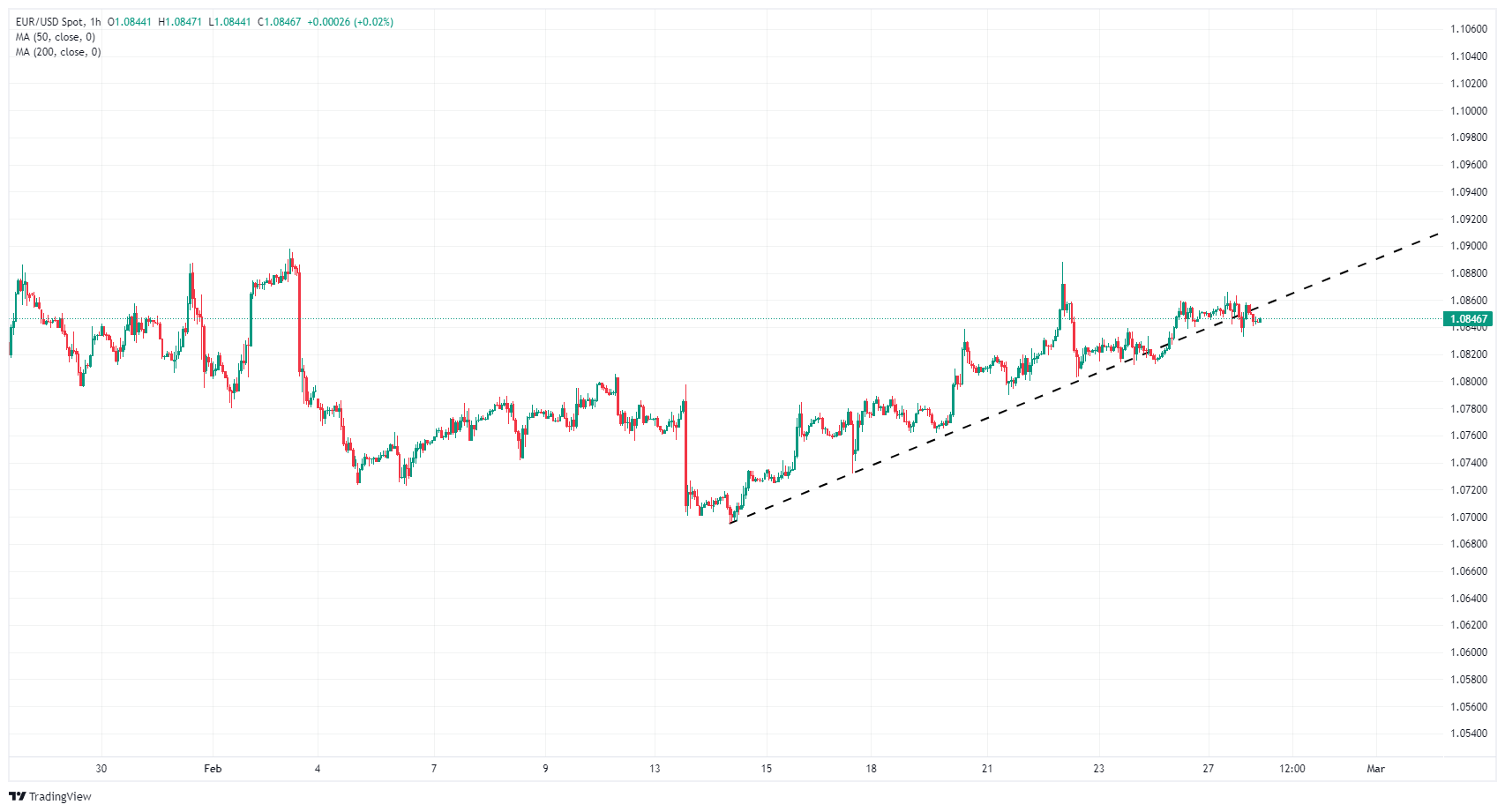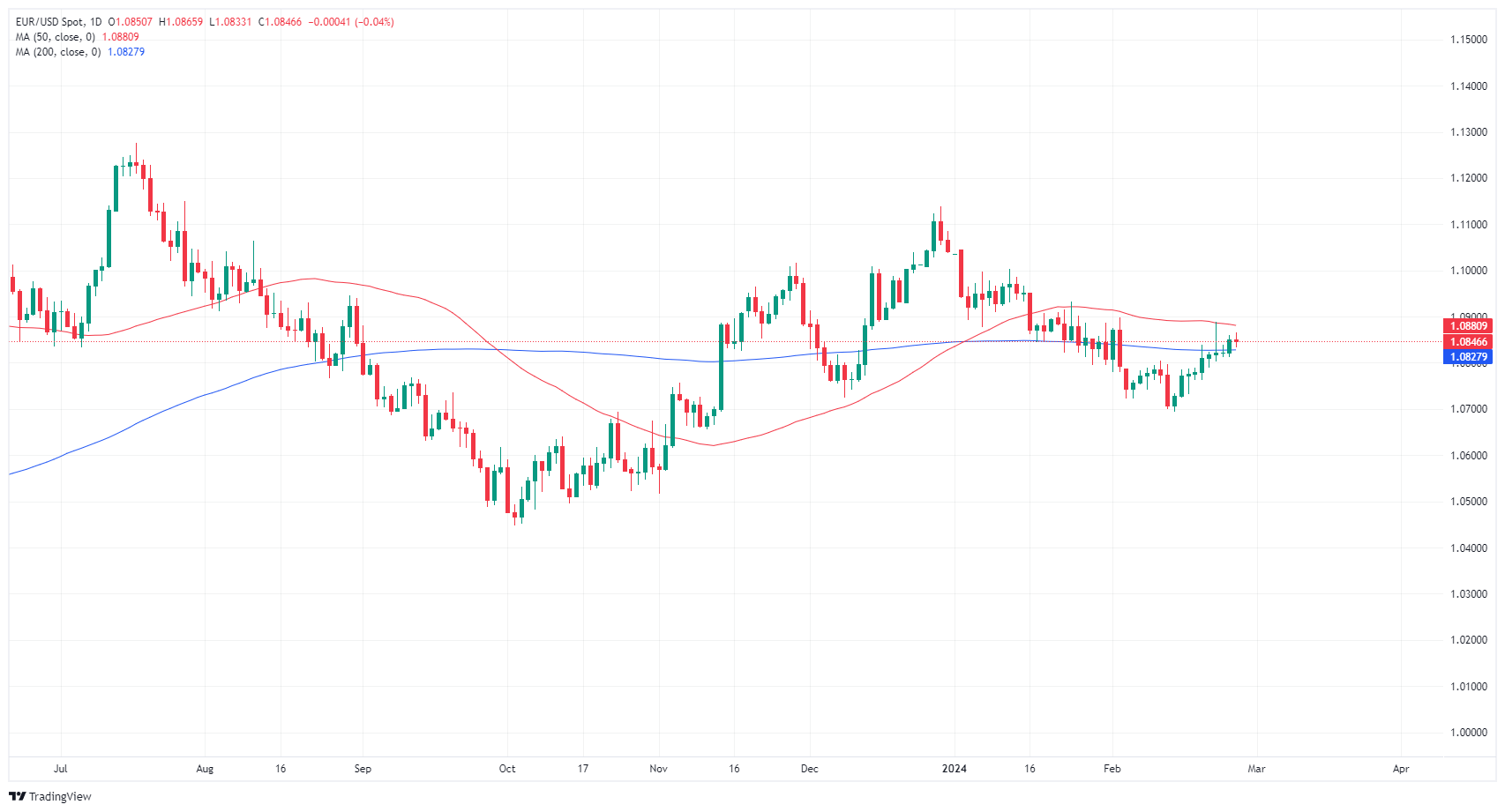- EUR/USD consolidates as markets await key US data.
- US Durable Goods Orders declined more than expected.
- US GDP on Wednesday, German CPI inflation on Thursday.
EUR/USD remains strung along the middle near 1.0850 after Tuesday brought little to push the pair in either direction after US Durable Goods Orders declined further than forecast in January. Markets await the latest Gross Domestic Product (GDP) figures from the US on Wednesday.
German Retail Sales and Consumer Price Index (CPI) inflation is slated for Thursday, followed by the US Personal Consumption Expenditure Price Index (PCE) inflation print.
Daily digest market movers: EUR/USD drifts ahead of GDP and inflation figures
- US Durable Goods Orders printed at -6.1% in January, down from the -4.5% forecast compared to the previous month’s -0.3%.
- Germany’s Gfk Consumer Confidence Survey for March came in at the expected -29.0, recovering slightly from the revised previous -29.6.
- US GDP is expected to remain at 3.3% for the annualized fourth quarter on Wednesday.
- Thursday’s German Retail Sales are forecast to print at -1.5% versus the previous -1.7%.
- Germany’s CPI inflation for the year ended February is expected to print at 2.6% versus the previous 2.9%.
- US Core PCE inflation is expected to decrease slightly to 2.8% from the previous 2.9%.
Euro price today
The table below shows the percentage change of Euro (EUR) against listed major currencies today. Euro was the strongest against the Canadian Dollar.
| USD | EUR | GBP | CAD | AUD | JPY | NZD | CHF | |
| USD | 0.03% | 0.01% | 0.19% | -0.09% | -0.04% | -0.09% | -0.10% | |
| EUR | -0.03% | 0.00% | 0.15% | -0.08% | -0.12% | -0.15% | -0.19% | |
| GBP | 0.00% | 0.03% | 0.16% | -0.09% | -0.03% | -0.13% | -0.14% | |
| CAD | -0.18% | -0.17% | -0.20% | -0.29% | -0.24% | -0.29% | -0.33% | |
| AUD | 0.10% | 0.12% | 0.08% | 0.28% | 0.01% | -0.04% | -0.06% | |
| JPY | 0.05% | 0.07% | 0.06% | 0.22% | -0.05% | -0.07% | -0.06% | |
| NZD | 0.08% | 0.14% | 0.11% | 0.29% | 0.01% | 0.05% | 0.02% | |
| CHF | 0.16% | 0.20% | 0.17% | 0.35% | 0.07% | 0.13% | 0.06% |
The heat map shows percentage changes of major currencies against each other. The base currency is picked from the left column, while the quote currency is picked from the top row. For example, if you pick the Euro from the left column and move along the horizontal line to the Japanese Yen, the percentage change displayed in the box will represent EUR (base)/JPY (quote).
Technical analysis: EUR/USD churns near 1.0850
EUR/USD saw tight trading on Tuesday, drifting around 1.0850 after a quick recovery from the day’s low near 1.0833. The pair remains in a near-term pattern of higher lows, but an intraday ceiling near 1.0860 remains a key resistance level.
Despite firm technical resistance, EUR/USD has closed in the green for the last nine trading days as the pair drifts into the 200-day Simple Moving Average (SMA) at 1.0830. Upside momentum remains capped by last week’s peak bids near 1.0888.
EUR/USD hourly chart
EUR/USD daily chart
Euro FAQs
What is the Euro?
The Euro is the currency for the 20 European Union countries that belong to the Eurozone. It is the second most heavily traded currency in the world behind the US Dollar. In 2022, it accounted for 31% of all foreign exchange transactions, with an average daily turnover of over $2.2 trillion a day.
EUR/USD is the most heavily traded currency pair in the world, accounting for an estimated 30% off all transactions, followed by EUR/JPY (4%), EUR/GBP (3%) and EUR/AUD (2%).
What is the ECB and how does it impact the Euro?
The European Central Bank (ECB) in Frankfurt, Germany, is the reserve bank for the Eurozone. The ECB sets interest rates and manages monetary policy.
The ECB’s primary mandate is to maintain price stability, which means either controlling inflation or stimulating growth. Its primary tool is the raising or lowering of interest rates. Relatively high interest rates – or the expectation of higher rates – will usually benefit the Euro and vice versa.
The ECB Governing Council makes monetary policy decisions at meetings held eight times a year. Decisions are made by heads of the Eurozone national banks and six permanent members, including the President of the ECB, Christine Lagarde.
How does inflation data impact the value of the Euro?
Eurozone inflation data, measured by the Harmonized Index of Consumer Prices (HICP), is an important econometric for the Euro. If inflation rises more than expected, especially if above the ECB’s 2% target, it obliges the ECB to raise interest rates to bring it back under control.
Relatively high interest rates compared to its counterparts will usually benefit the Euro, as it makes the region more attractive as a place for global investors to park their money.
How does economic data influence the value of the Euro?
Data releases gauge the health of the economy and can impact on the Euro. Indicators such as GDP, Manufacturing and Services PMIs, employment, and consumer sentiment surveys can all influence the direction of the single currency.
A strong economy is good for the Euro. Not only does it attract more foreign investment but it may encourage the ECB to put up interest rates, which will directly strengthen the Euro. Otherwise, if economic data is weak, the Euro is likely to fall.
Economic data for the four largest economies in the euro area (Germany, France, Italy and Spain) are especially significant, as they account for 75% of the Eurozone’s economy.
How does the Trade Balance impact the Euro?
Another significant data release for the Euro is the Trade Balance. This indicator measures the difference between what a country earns from its exports and what it spends on imports over a given period.
If a country produces highly sought after exports then its currency will gain in value purely from the extra demand created from foreign buyers seeking to purchase these goods. Therefore, a positive net Trade Balance strengthens a currency and vice versa for a negative balance.
GDP FAQs
What is GDP and how is it recorded?
A country’s Gross Domestic Product (GDP) measures the rate of growth of its economy over a given period of time, usually a quarter. The most reliable figures are those that compare GDP to the previous quarter e.g Q2 of 2023 vs Q1 of 2023, or to the same period in the previous year, e.g Q2 of 2023 vs Q2 of 2022.
Annualized quarterly GDP figures extrapolate the growth rate of the quarter as if it were constant for the rest of the year. These can be misleading, however, if temporary shocks impact growth in one quarter but are unlikely to last all year – such as happened in the first quarter of 2020 at the outbreak of the covid pandemic, when growth plummeted.
How does GDP influence currencies?
A higher GDP result is generally positive for a nation’s currency as it reflects a growing economy, which is more likely to produce goods and services that can be exported, as well as attracting higher foreign investment. By the same token, when GDP falls it is usually negative for the currency.
When an economy grows people tend to spend more, which leads to inflation. The country’s central bank then has to put up interest rates to combat the inflation with the side effect of attracting more capital inflows from global investors, thus helping the local currency appreciate.
How does higher GDP impact the price of Gold?
When an economy grows and GDP is rising, people tend to spend more which leads to inflation. The country’s central bank then has to put up interest rates to combat the inflation. Higher interest rates are negative for Gold because they increase the opportunity-cost of holding Gold versus placing the money in a cash deposit account. Therefore, a higher GDP growth rate is usually a bearish factor for Gold price.
Information on these pages contains forward-looking statements that involve risks and uncertainties. Markets and instruments profiled on this page are for informational purposes only and should not in any way come across as a recommendation to buy or sell in these assets. You should do your own thorough research before making any investment decisions. FXStreet does not in any way guarantee that this information is free from mistakes, errors, or material misstatements. It also does not guarantee that this information is of a timely nature. Investing in Open Markets involves a great deal of risk, including the loss of all or a portion of your investment, as well as emotional distress. All risks, losses and costs associated with investing, including total loss of principal, are your responsibility. The views and opinions expressed in this article are those of the authors and do not necessarily reflect the official policy or position of FXStreet nor its advertisers. The author will not be held responsible for information that is found at the end of links posted on this page.
If not otherwise explicitly mentioned in the body of the article, at the time of writing, the author has no position in any stock mentioned in this article and no business relationship with any company mentioned. The author has not received compensation for writing this article, other than from FXStreet.
FXStreet and the author do not provide personalized recommendations. The author makes no representations as to the accuracy, completeness, or suitability of this information. FXStreet and the author will not be liable for any errors, omissions or any losses, injuries or damages arising from this information and its display or use. Errors and omissions excepted.
The author and FXStreet are not registered investment advisors and nothing in this article is intended to be investment advice.
Recommended content
Editors’ Picks

AUD/USD bulls remain on the sidelines amid mixed cues
AUD/USD remains below the 0.6300 mark during the Asian session on Friday as the US tariff uncertainty continues to weigh on investors' sentiment. However, bets that the Fed will cut interest rates thrice in 2025 fail to assist the USD to build on this week's modest bounce from a multi-month low and act as a tailwind for the currency pair.

USD/JPY edges higher to 148.00; not out of the woods yet
USD/JPY ticks higher during the Asian session on Friday, yet the near-term bias leans bearish, driven by divergent BoJ-Fed expectations. Global trade war fears and risk-off mood support the safe-haven JPY. Limited USD buying confirms the pair's negative outlook.

Gold price sits near the all-time high; $3,000 in sight.
Gold consolidates its record high rally, remaining near $3,000. Rising trade tensions underpin the safe-haven bullion. Fed rate-cut expectations and subdued USD demand benefit the non-yielding yellow metal.

Stablecoin regulatory bill receives green light during Banking Committee hearing
The US Senate Banking Committee voted on Thursday to advance the Guiding and Establishing National Innovation for US Stablecoins Act, which aims to establish proper regulations for stablecoin payments in the country.

Brexit revisited: Why closer UK-EU ties won’t lessen Britain’s squeezed public finances
The UK government desperately needs higher economic growth as it grapples with spending cuts and potential tax rises later this year. A reset of UK-EU economic ties would help, and sweeping changes are becoming more likely.

The Best brokers to trade EUR/USD
SPONSORED Discover the top brokers for trading EUR/USD in 2025. Our list features brokers with competitive spreads, fast execution, and powerful platforms. Whether you're a beginner or an expert, find the right partner to navigate the dynamic Forex market.